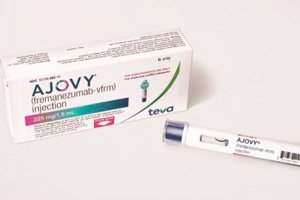
All iLive content is medically reviewed or fact checked to ensure as much factual accuracy as possible.
We have strict sourcing guidelines and only link to reputable media sites, academic research institutions and, whenever possible, medically peer reviewed studies. Note that the numbers in parentheses ([1], [2], etc.) are clickable links to these studies.
If you feel that any of our content is inaccurate, out-of-date, or otherwise questionable, please select it and press Ctrl + Enter.
Migraine in children can now be prevented “like adults”: FDA approves Ajovy for children aged 6 and older
Last reviewed: 18.08.2025
 ">
">The U.S. Food and Drug Administration (FDA) has approved Ajovy (fremanezumab-vfrm) for the prevention of episodic migraine in children and adolescents aged 6 to 17 years who weigh ≥ 45 kg. It is the first and only anti-CGRP drug approved for pediatric migraine prophylaxis (Ajovy has been available in adults since 2018). The drug is administered once a month at 225 mg/1.5 mL, is available in an auto-injector or syringe, and can be administered at home under the supervision of a physician.
Why is this important?
In the United States, one in ten children and adolescents experiences migraine, a disease that is often underestimated: attacks lead to missed classes, a drop in academic performance, and social difficulties. Until now, pediatric prevention has relied mainly on “repurposing” adult off-label regimens. The emergence of an officially approved drug closes a gap in pediatric care.
What exactly is approved?
- Indication: Prevention of episodic migraine in 6-17 year olds weighing ≥ 45 kg (99 lb).
- Regimen: 225 mg subcutaneously once a month, without a starting loading dose.
- Form: pre-filled autoinjector or syringe; can be administered in the clinic or at home (self/parent after training).
In a press release, Teva emphasizes: Ajovy is the first and only CGRP antagonist officially approved for both pediatric episodic migraine prophylaxis and migraine prophylaxis in adults.
How much does it help?
The basis for expanding the indications was the data from phase 3 (the SPACE study) in children and adolescents:
- reduction in the number of days with migraine per month by -2.5 versus -1.4 with placebo;
- reduction in days with headache by -2.6 versus -1.5;
- proportion of patients with ≥50% response: 47.2% on Ajovy vs 27.0% on placebo.
The safety profile was comparable to placebo, with serious AEs rare.
What the experts say
“Childhood migraine is a complex condition that impacts both learning and emotional well-being. The availability of an FDA-approved preventive option provides us with a targeted tool that can reduce the frequency of attacks in younger patients,” says pediatric neurologist Jennifer McVeagh (DENT Neurologic Institute).
Safety and restrictions
The most common side effects are injection site reactions (pain, redness). Hypersensitivity (rash, itching) has been reported rarely; as with the entire class of anti-CGRP agents, the instructions include warnings about monitoring blood pressure and possible Raynaud's phenomenon. The decision on therapy is made by the doctor, especially if the child has concomitant diseases.
What this means for families and doctors
- For adolescents ≥45 kg with frequent attacks, this is a chance to move from “firefighting” treatment to once-a-month prevention, potentially with a lower drug burden and a more predictable schedule.
- For pediatricians and pediatric neurologists - an official option from the anti-CGRP class, with a clear regimen and accumulated “adult” experience.
- For the education system, it is an opportunity to reduce absences and academic consequences for some children.
What's next?
Ajovy will compete with other anti-CGRPs in adults, but it is the first in pediatric prophylaxis. The next steps are to accumulate “real-world” data in children (long-term efficacy/safety, impact on quality of life) and discuss expanding the indication below the 45 kg threshold or for chronic migraine – this will require separate studies.
